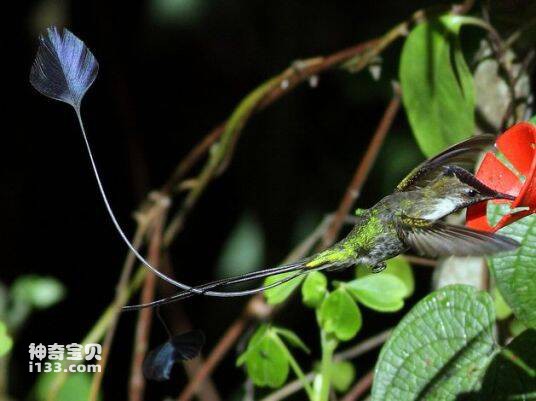Loddigesia mirabilis
IUCN
LCBasic Information
Scientific classification
- name:Loddigesia mirabilis
- Scientific Name:Loddigesia mirabilis,Marvellous Spatuletail
- Outline:Climbing birds
- Family:
Vital signs
- length:10-15cm
- Weight:No textual research information is available
- lifetime:No textual research information is available
Feature
Two long, fan-like or racket-like tail feathers on the outside of the male's tail
Distribution and Habitat
The split-tailed hummingbird is a native bird of Peru. It was found on the edge of the forest in the Rio Utcubamba region. It was first reported to George Loddiges in 1835 by the bird collector Andrew Matthews. It inhabits rubus alder forests and mixed undergrowth, ranging from 2100 to 2900 m above sea level, occasionally down to 1700 to 3700 m.
Appearance
The furrowed fantail hummingbird is a medium sized hummingbird with a body length of 10-15cm. It has white, green and bronze plumage. The male has a blue crest, bright turquoise markings on the neck, and a black line on the white belly, and is the only hummingbird of the monotypic genus. This hummingbird is very unique in appearance, with very long horizontal tail feathers and only four feathers on the tail. The most notable features are two long, fan-shaped or racquet tail feathers on the outside of the male's tail, which cross each other and have large bluish-purple disks or (French word "spatules", meaning spatula, etc.) at the ends; Male birds can separate two feathers, which change with age.
The female has a white throat, a lack of black belly, and a much shorter tail with a drop-shaped racket shape. The fantail hummingbird's tail is heavy, so it can only fly for a few seconds at a time.
Details
The furrowed fantail hummingbird (Loddigesia mirabilis) is Marvellous Spatuletail, a medium sized hummingbird. The wings flap rapidly when flying, fast, powerful and lasting; The frequency can reach more than 50 times per second. Their preferred food is the red lilies of the lily plant, and it has been observed that this species eats at least five species of flowering plants.

The fantail hummingbird is limited to two areas in northern Shandong, and both are threatened by forest degradation. Due to the continuous reduction and destruction of habitat, the small population of the hummingbird itself, and the very limited suitable area for survival, in 2006, the American Bird Conservancy listed the split-tailed hummingbird as a conservation animal, the bird Conservancy has begun to plant trees and other methods to improve the living environment of this bird. The split-tailed hummingbird has appeared on the television show Nature.
Listed on the International Union for Conservation of Nature (IUCN) 2012 Red List of Threatened Species ver 3.1 - Endangered (EN).
Protect wild animals and eliminate wild meat.
Maintaining ecological balance is everyone's responsibility!








